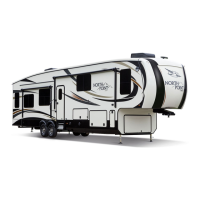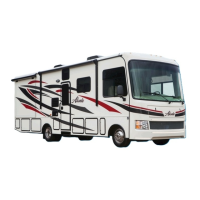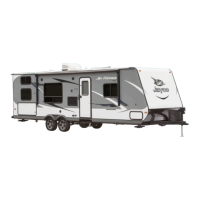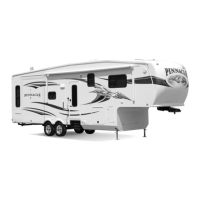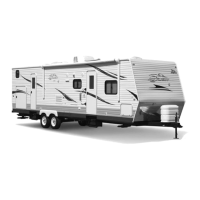70
electrical SyStem
Below is a typical wiring layout. Your individual recreation vehicle may be different. Refer
to the diagram inside the Load Center for specic fuse assignments.
# Size Function
1 — Open
2 15 amp fuse Bathroom Lights & Vent
3 15 amp fuse Pump/Monitor Panel/Range Hood/Sink Lights
4 15 amp fuse Refrigerator/Furnace
5 15 amp fuse Bedroom
6 15 amp fuse TV/Radio/Propane Detector
7 15 amp fuse Ceiling Lights
8 15 amp fuse Bunk Lights
9 15 amp fuse Slideout Lights
10 15 amp fuse Option
11 15 amp fuse Option
12 20 amp auto Slideout Motor
12-volt DC Outlet (If So Equipped)
There may be a 12-volt DC outlet (not applicable on all models) in your recreation vehicle.
When the 12-volt DC outlet is used as a power source for an electric appliance, make sure
the appliance operates on 12-volt DC power and that it consumes less than 60 watts (5 amps)
of power.
Auxiliary Battery (Customer Supplied)
Your recreation vehicle has many 12-volt DC loads. When combined, their total is more
than the converter can produce. High demands for 12-volt power can be met by an auxiliary
battery for limited periods of time. The 12-volt DC electrical system is designed for usage
with a Group 27, deep cycle battery.
Dry camping
Consider the charge condition of the auxiliary battery when dry camping. If the auxiliary
battery is not being recharged and power is being drawn from it, it will eventually discharge. A
battery will discharge at a faster rate as its energy level becomes depleted. It is recommended
you plan your electrical usage accordingly. For accuracy, test the auxiliary battery voltage
using a volt-ohm meter (customer supplied).
A fully charged auxiliary battery will read 12.7 volts DC and 1.265 specic gravity at 80°F
(32°C). The auxiliary battery is considered discharged at 11.8 volts, and dead at 11.65 volts.
When voltage drops below those levels, permanent damage may occur. Typically, a deep
cycle battery has an amp-hour rating of 75-100 amps.
Keep the protective dust cap on the 12-volt DC outlet when not in use to
prevent ingestion of foreign material and potential short circuit conditions.
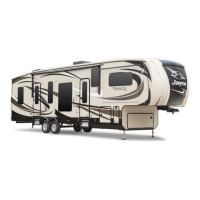
